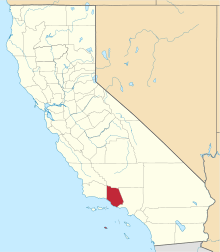Conejo Valley

The Conejo Valley is a region spanning both southeastern Ventura County and northwestern Los Angeles County in Southern California, United States.
History
The first human residents of Conejo valley were the native Chumash people. Local villagers' first contact with Europeans came in 1770. The Spanish exploratory party led by Gaspar de Portolá, returning from its journey up the coast as far as present-day San Francisco, entered the valley from the northwest. On the outward bound journey, the explorers had traveled up the Los Angeles River, ascended the Grapevine to Castaic Junction, then followed the Santa Clara River back down to the coast. On the return trip, they sought a shorter route to the San Fernando Valley, and were guided by natives up and over today's Conejo Grade. Franciscan missionary Juan Crespi kept a diary of the expedition, and gave Conejo Valley one name that survives today – Triunfo (Spanish for "triumph").[1] Crespi gave the name El triunfo del Dulcísimo Nombre de Jesús (in English: The Triumph of the Sweetest Name of Jesus) to a camping place by a creek – today's Triunfo Canyon Road begins between Thousand Oaks and Westlake Village.
Later, explorer Juan Bautista de Anza used Portolá's shortcut on his way north in 1774, mentioning in his diary a stop at "El Triunfo".[2] On de Anza's second expedition (1775–76), diarist Father Pedro Font referred to "many watering places, like those of El Triunfo and Los Conejos".[3] In 1803, the Spanish land grant in the area was given the name Rancho El Conejo.
In Spanish, conejo means "rabbit", and refers to the rabbits common to the region,[4] specifically the desert cottontail and brush rabbit species.[5] It is located in the northwestern part of the Greater Los Angeles Area.
Geography
The area is bordered by the San Fernando Valley and the city of Los Angeles to the east, Simi Hills to the north, Las Posas Hills and the Santa Rosa Valley to the northwest, Conejo Mountain (also known as Conejo Hills) and Oxnard Plain to the west, and the Santa Monica Mountains and Malibu to the south, the Westside, and Pacific Ocean beyond it. The valley is located in the Santa Monica Mountains on an elevated area.
Economy
Many high-tech companies, particularly those in biotechnology, including Amgen, Baxter, General Dynamics Corporation, and Rockwell International are prevalent in the area. It also includes many other tech corporations, especially dot com companies and telecommunications like Verizon and Verizon Wireless. It also is home to many healthcare and other various companies like WellPoint, J.D. Power and Associates, Volkswagen, Audi, THQ, SAGE Publications, MacTech and cosmetics leader JAFRA Cosmetics. Although the region is predominantly white with a large Hispanic minority, there is a small, but growing, Asian minority in the region.
Plantation
Harold and Edwin Janss purchased ten thousand acres (40 km²) of land of what is now central Thousand Oaks from the heir of John Edwards, who had purchased the land from the de la Guerra heirs (all of the land was originally a portion of the Rancho El Conejo land grant) in 1910. A ranch, named the Janss Conejo Ranch, was utilized as a farm and to raise thoroughbred horses with the Santa Susanna Mountains and Simi Hills framing it. Television Westerns such as The Rifleman, Gunsmoke, and Bonanza were filmed in Janss Conejo between the 1950s and 1960s. It was also used as the filming locations for Disney's Davy Crockett, King of the Wild Frontier and Westward Ho, the Wagons! both starring Fess Parker.
Tourism
In 2013 the Conejo Valley Tourism Improvement District (CVTID) was formed by the cities of Thousand Oaks and Agoura Hills.[6] CVTID is a non-profit corporation that markets Conejo Valley as a Tourist Destination.[7] Conejo Valley's two largest tourist attractions are the Ronald Reagan Presidential Library (Simi Valley, specifically) and the Santa Monica Mountains National Recreation Area.
Communities
Cities and communities:
- Agoura Hills
- Calabasas (a portion[8])
- Lake Sherwood
- Newbury Park
- Oak Park
- Thousand Oaks
- Westlake Village
See also
- Geography of Thousand Oaks, California
References
- ↑ Bolton, Herbert E. (1927). Fray Juan Crespi: Missionary Explorer on the Pacific Coast, 1769-1774. HathiTrust Digital Library. p. 267. Retrieved March 2014. Check date values in:
|access-date=(help) - ↑ Bolton, Herbert E. (1930). Anza's California Expeditions, Volume II. Internet Archive. p. 102. Retrieved March 2014. Check date values in:
|access-date=(help) - ↑ Bolton, Herbert E. (1930). Anza's California Expeditions, Volume IV. Internet Archive. p. 247. Retrieved March 2014. Check date values in:
|access-date=(help) - ↑ Nelson, Frank (July 6, 2008). "Conejo Oaks: An animal oasis". Los Angeles Times. Retrieved 2009-06-14.
- ↑ City of Thousand Oaks (July 2, 1996), Conservation of the Thousand Oaks General Plan (PDF), p. 51, retrieved 2009-06-14
- ↑ http://www.toaks.org/civica/filebank/blobdload.asp?BlobID=25716
- ↑ Conejo Valley Tourism Improvement District, Conejo Valley Tourism Improvement District (CVTID) Public Documents
- ↑ Colantuono, Michael G. (City Attorney) (22 March 2005). "New Housing Legislation (SB 699, SB 1102, SB 1777, AB 2158, AB 2348)" (PDF). City of Calabasas. p. 2. Retrieved 8 May 2014.
...such as those for the Conejo Valley subregion in which the City is located
External links
 Media related to Conejo Valley at Wikimedia Commons
Media related to Conejo Valley at Wikimedia Commons
Coordinates: 34°21′36″N 119°09′00″W / 34.36000°N 119.15000°W
